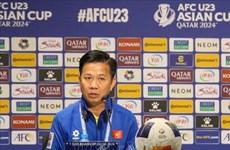Dragon Bridge: symbol of lighting design industry
Vietnam's Cau Rong (Dragon Bridge) earned a Special Citation award at
the 31st Annual International Lighting Design Awards last month.
Vietnam's Cau Rong (Dragon Bridge) earned a Special Citation award at
the 31st Annual International Lighting Design Awards last month.
The world's largest dragon-shaped steel bridge beat out more than 200 entries from ten countries to become one of 16 award winners. A major landmark of central Da Nang city, it has recently been featured on CNN as "Da Nang's fiery new success symbol".
The mastermind behind the bridge is designer Tran Van Thanh, director of ASA Lighting Design Studios, who earned a Master's and a PhD in lighting design in Germany and the UK, respectively. He spoke to Vietnam News.
*How do you view the significance of the award?
The award is of great significance. It's universally heralded as the top honour in the lighting design industry. The project was recognised by a professional panel of judges working independently.
It was the first time that a lighting project designed by a Vietnamese company received such a prestigious award. This means Vietnam has successfully made a name for itself in the world of lighting design.
Nevertheless, the award is not surprising at all to me. I was always convinced that our project was unique and one-of-a-kind.
*How is the Dragon Bridge unique?
The name Cau Rong tells it all: a bridge and a dragon. It functions as both traffic infrastructure and an attractive sight. While the dragon bears a spiritual and sacred meaning, the project is also eye-catching, with a dramatic curving shape and dynamic colour-changing lighting.
*What challenges did you and your associates encounter when working on the project?
It took us between two and three years to complete the project. This was our first lighting project. We had to create a unique structure, while also ensuring that it would not affect traffic.
The dragon is a respected animal according to eastern belief, so we avoided caricaturing it. But if we made it too solemn, it would not be attractive.
We drew out various schemes. At one point, we even thought of colouring it blue or red. But a red dragon would look extremely cruel. The animal should look friendly and peaceful.
Lighting design is still in its early years in Vietnam, where there is no full-time lighting design education. My colleagues came from different fields and fell short of professionalism. The lack of guidelines and standards also made things difficult for us.
*From the perspective of an ordinary person, how do you see the effect of the Dragon Bridge?
It's no secret that people are attracted to well-lit public facilities. I have seen radical changes in the life of many local residents. In the past, on the way back home from work, I found the area around the Dragon Bridge dark and deserted, although it was barely 8pm.
The area is completely different now. It is crammed with locals and tourists every night, especially during the weekends, when the beautifully lit bridge breathes fire and sprays water. In addition, many people have seen their incomes considerably rise from selling sugar-cane juice or other types of services for visitors.
*How is the lighting design field developing in Vietnam?
The lighting design industry in the world is rather new, and has been in form for about 30 years. Therefore, it is particularly new in Vietnam, where it is mostly concentrated in hotels and restaurants and entertainment venues. However, more and more people express interest in lighting design because they see that it adds value to venues.
When I established my business two years ago, most of my customers were foreigners who already understood the role of lighting in architecture. Through initial projects, we tried to help clients (particularly Vietnamese) understand the role of lighting designers and the value of lighting, boost energy efficiency and reduce lighting costs. Now, I have many Vietnamese clients who have returned for other projects.-VNA
The world's largest dragon-shaped steel bridge beat out more than 200 entries from ten countries to become one of 16 award winners. A major landmark of central Da Nang city, it has recently been featured on CNN as "Da Nang's fiery new success symbol".
The mastermind behind the bridge is designer Tran Van Thanh, director of ASA Lighting Design Studios, who earned a Master's and a PhD in lighting design in Germany and the UK, respectively. He spoke to Vietnam News.
*How do you view the significance of the award?
The award is of great significance. It's universally heralded as the top honour in the lighting design industry. The project was recognised by a professional panel of judges working independently.
It was the first time that a lighting project designed by a Vietnamese company received such a prestigious award. This means Vietnam has successfully made a name for itself in the world of lighting design.
Nevertheless, the award is not surprising at all to me. I was always convinced that our project was unique and one-of-a-kind.
*How is the Dragon Bridge unique?
The name Cau Rong tells it all: a bridge and a dragon. It functions as both traffic infrastructure and an attractive sight. While the dragon bears a spiritual and sacred meaning, the project is also eye-catching, with a dramatic curving shape and dynamic colour-changing lighting.
*What challenges did you and your associates encounter when working on the project?
It took us between two and three years to complete the project. This was our first lighting project. We had to create a unique structure, while also ensuring that it would not affect traffic.
The dragon is a respected animal according to eastern belief, so we avoided caricaturing it. But if we made it too solemn, it would not be attractive.
We drew out various schemes. At one point, we even thought of colouring it blue or red. But a red dragon would look extremely cruel. The animal should look friendly and peaceful.
Lighting design is still in its early years in Vietnam, where there is no full-time lighting design education. My colleagues came from different fields and fell short of professionalism. The lack of guidelines and standards also made things difficult for us.
*From the perspective of an ordinary person, how do you see the effect of the Dragon Bridge?
It's no secret that people are attracted to well-lit public facilities. I have seen radical changes in the life of many local residents. In the past, on the way back home from work, I found the area around the Dragon Bridge dark and deserted, although it was barely 8pm.
The area is completely different now. It is crammed with locals and tourists every night, especially during the weekends, when the beautifully lit bridge breathes fire and sprays water. In addition, many people have seen their incomes considerably rise from selling sugar-cane juice or other types of services for visitors.
*How is the lighting design field developing in Vietnam?
The lighting design industry in the world is rather new, and has been in form for about 30 years. Therefore, it is particularly new in Vietnam, where it is mostly concentrated in hotels and restaurants and entertainment venues. However, more and more people express interest in lighting design because they see that it adds value to venues.
When I established my business two years ago, most of my customers were foreigners who already understood the role of lighting in architecture. Through initial projects, we tried to help clients (particularly Vietnamese) understand the role of lighting designers and the value of lighting, boost energy efficiency and reduce lighting costs. Now, I have many Vietnamese clients who have returned for other projects.-VNA












